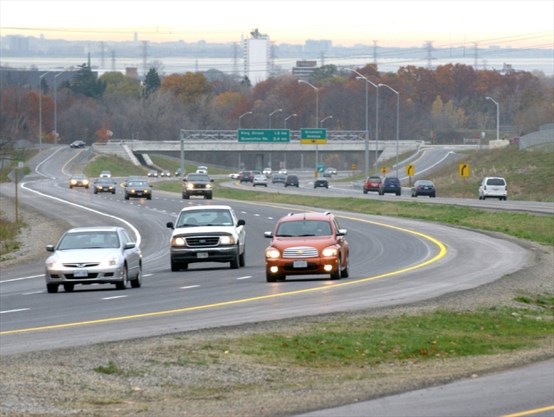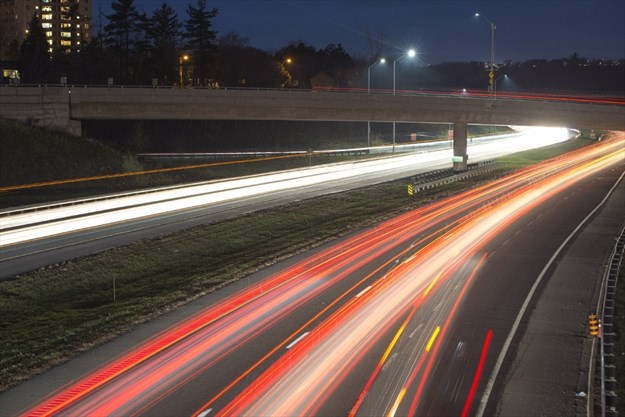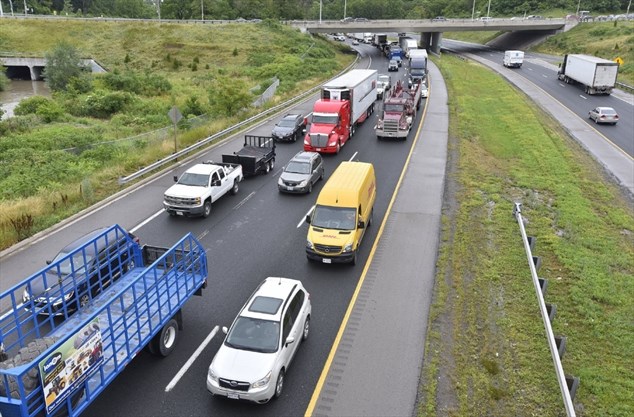Testing done to address slipperiness concerns
The City of Hamilton has hired a consultant to test the asphalt on the Red Hill Valley Parkway — results expected to show once and for all whether there is a problem with the material.
The parkway has been the subject of complaints regarding slippery pavement since it opened in 2007. Friction testing done in December 2015 was inconclusive, and a consultant recommended further testing; instead the city opted to repave ahead of schedule starting later this year.
“We don’t know why they feel that it’s slippery,” said Gary Moore, director of engineering. “That’s all part of (why the city is doing) the testing.”
The testing includes samples that were collected before Christmas being sent to Ireland for specialized analysis. The city needs a comprehensive look at the asphalt mix to know if it can be recycled during repaving using a new technique being explored by the city, he said.
Slippery roadways have been among the concerns expressed by the grieving families who have lost loved ones in crashes along the parkway.
But the major rallying point has been a call for median barriers along the Red Hill and the connecting Lincoln Alexander Parkway, to prevent crossover crashes where cars travel through the median onto the other side.
After an emotional appeal from families in October, the city agreed to study the issue further. However, a report going to the public works committee Monday says barriers are not being considered right now. Instead, staff is recommending holding off until the parkways are expanded. However, there is no clear timeline for when that may happen and any parkway expansion is contingent on the connecting Highway 403 and QEW expanding first.
Ontario Minister of Transportation Steven Del Duca told the city that environmental assessments are ongoing and there is no set timeline for expanding the highways here.
For the families who have been fighting for barriers, the report is not surprising, but “very disappointing,” said Corey and Léony Hastings.
Their daughter and stepdaughter Jordyn Hastings died in a crossover crash on the parkway May 5, 2015, alongside her best friend, Olivia Smosarski. Both girls were 19.
The crash occurred between the King Street East ramp and Greenhill Avenue — one of two particularly crash-prone stretches on the parkway.
The Hastings point out the city still has done nothing to address these “hot spots.” And the other measures to reduce speed “still won’t prevent crossover fatalities,” they said.
Crossover crashes represent a small percentage of overall crashes on the Linc (5 per cent) and Red Hill (3 per cent), the report notes. But statistics also show crossover crashes are 50 per cent of the dozen fatalities on the two parkways.
Other “collision counter measures,” include better signage, plans to study lowering the speed limit and (depending on provincial legislation) a push to look at possible photo radar.
“The installation of barriers would greatly reduce the likelihood of crossover incidents occurring: however there are other potential impacts that may arise,” the report says.
Experts say barriers can increase the number of crashes, but tend to decrease the severity — namely they can prevent deadly crossovers.
“In addition, the installation of barriers does not directly address the primary root cause of the collisions, speeding, aggressive and distracted driving,” the report says.
The city’s transportation staff declined to comment before the report was presented to councillors.
Both parkways have experienced higher than expected traffic volume and statistics show speeding remains the top factor in all crashes.
However, a Spectator investigation published this summer found the Red Hill had more than twice as many crashes than the connecting Lincoln M. Alexander Parkway over the last five years, despite lower traffic volumes.
Crashes there are most likely in curvy parts of the road, when the ground is wet.
Sarah Warry-Poljanski, a community activist who previously sought the provincial Conservative nomination in Hamilton Mountain, helped organize the delegation for the families who pleaded with council in October.
She accused the city of focusing too much on driver behaviour, particularly speeding, which was not a factor in many fatal crashes. Missie Sholer, whose 25-year-old brother, Michael Sholer, died in a crossover crash on the RHVP Jan. 25, 2017, agreed.
“From this report I gather … the city’s main concern is money,” Warry-Poljanski said, later adding that she believes most people would accept spending money to install safety measures.
When the Red Hill Valley Parkway was built, it was one of the first in Ontario to use perpetual pavement — a design that uses multiple layers that last longer. The Linc, which does not use a perpetual pavement design, was last repaved in 2011, and is expected to be repaved again in 2020.
The city is exploring using a newer technology for resurfacing the Red Hill that includes a train of machines that moves over the asphalt — heating, scraping up the first 50 millimetres, mixing it with new material and then laying it back down, Moore said.
The technology is popular in British Columbia and is getting a test run in Ontario near Thunder Bay, he added.
Moore said if they are able to make use of the newer technology it will save time and money.
The repaving work will also include adding cat-eye reflectors along all of the parkways and shoulder rumble strips on the Linc.
Source: The Hamilton Spectator




